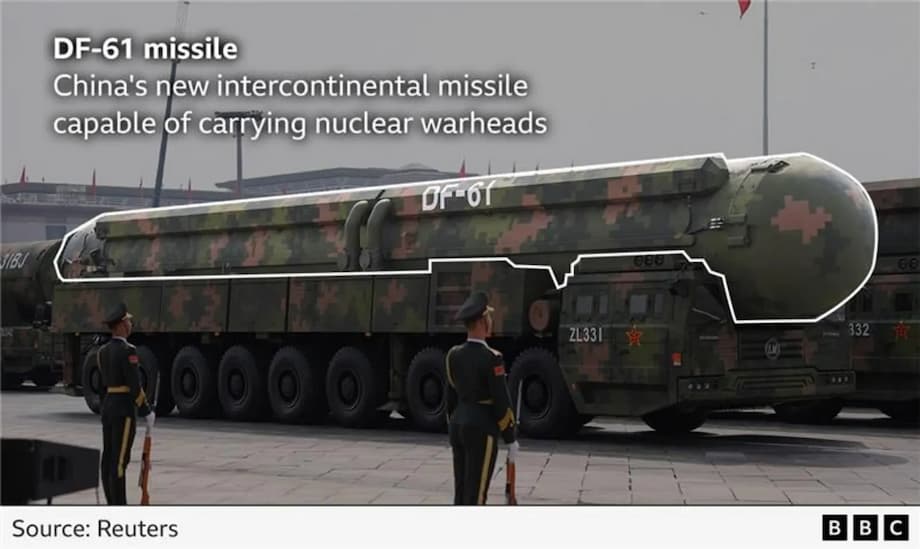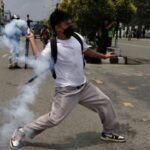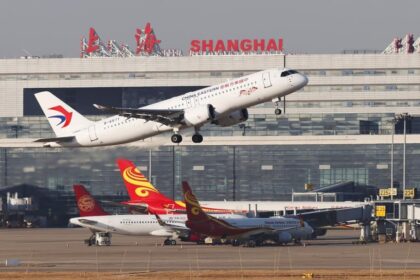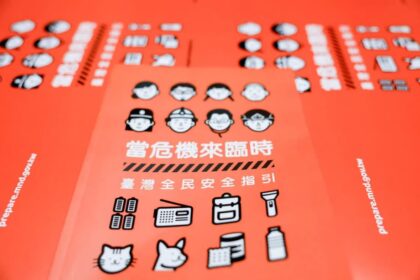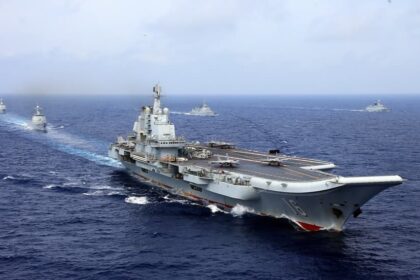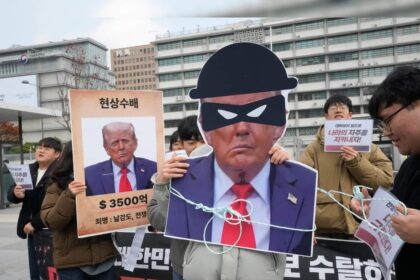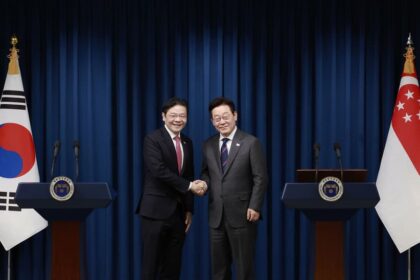A parade built to send a message
China staged one of its largest military parades in years in central Beijing, unveiling missiles, drones, lasers and armored vehicles in a display aimed well beyond its domestic audience. The pageantry served a strategic purpose. It showcased new hardware and China’s ability to build complex systems at scale, while also signaling political solidarity with Russia and North Korea. President Xi Jinping stood alongside Russia’s Vladimir Putin and North Korea’s Kim Jong Un before a crowd of tens of thousands. More than two dozen foreign leaders attended, while the United States and key allies stayed away.
- A parade built to send a message
- What China showed, and why it matters
- Nuclear forces on open display
- The maritime plan, boxing out foreign navies
- AI, robotics and a changing command culture
- How much is real and ready
- Geopolitics on the reviewing stand
- What it means for Taiwan and U.S. forces
- What to watch next
- Highlights
The weaponry on show pointed to a sharpened focus on deterring the United States and shaping the security environment in East Asia, including the waters around Taiwan. Hypersonic anti-ship missiles, extra large undersea drones and a new generation of intercontinental missiles rolled past Tiananmen Square. Fighter jets thundered overhead, and new air defense and space related systems were revealed for the first time.
In his address to the assembled troops and dignitaries, Xi framed the moment as proof of national resilience and resolve. He sought to rally public pride at home and send a warning abroad.
Introducing his remarks as commander in chief and head of the Central Military Commission, Xi told the crowd what he believes about China’s place in the world. He said the country would not be cowed by rivals.
“The Chinese nation is the great nation that is never intimidated by any bullies.”
The parade also functioned as a global showroom for Chinese arms manufacturers. With many leaders from the Global South in attendance, Beijing used the spectacle to court future buyers and deepen partnerships that complicate Washington’s defense planning.
What China showed, and why it matters
For years, critics dismissed Chinese equipment as copies of Western designs. The parade suggested that era is fading. The lineup displayed breadth and speed of development across missiles, unmanned systems, naval air defense and armored platforms. Analysts caution that some items may still be prototypes or limited deployments. Even so, the variety and volume of systems on display suggest a defense industry that can field new designs quickly and in significant numbers.
Missiles that target bases and ships
The most striking theme was long range strike. China paraded a new intercontinental ballistic missile, the DF-61, alongside a modernized DF-5C that Chinese media say can carry multiple independently targetable warheads. A missile labeled DF-31BJ hinted at expansion of land based nuclear forces and possible silo deployment. The DF-26D, an anti-ship variant often dubbed the Guam killer, underscored the focus on threatening U.S. bases and carrier groups across the Western Pacific.
China also emphasized anti-ship and land attack cruise missiles. New YJ series missiles, including the YJ-17, YJ-19 and YJ-20, were presented as high speed or hypersonic threats intended to overwhelm naval defenses. These systems are designed to arrive from different angles and altitudes, complicating interception. A strategic strike grouping of CJ-20A cruise missiles also appeared, signaling continued investment in precision conventional strike.
Hypersonic flight matters because a missile traveling at least five times the speed of sound and maneuvering unpredictably can compress decision time for defenders. The effect is to increase the risk to ships and forward bases, even if not every new missile is yet in full service.
Drones above and below the waves
Unmanned systems took a prominent role. The AJX002 extra large uncrewed undersea vehicle, a torpedo shaped craft over 18 meters long, suggests ambitions to surveil and possibly contest the undersea domain. The HSU100 underwater drone, an unnamed surface drone geared for mine warfare, and other mysterious undersea devices hinted at a layered maritime robotics program.
In the air, the stealthy GJ-11 flying wing and a loyal wingman drone designed to operate alongside manned fighters signaled a push to pair human pilots with autonomous teammates. Remote controlled armored buggies for mine clearing and casualty evacuation appeared as part of a broader embrace of robots across the force.
Ground and air platforms
On land, the new Type 100 main battle tank rolled past with features described in state media as highly intelligent. It reportedly uses an unmanned turret, advanced sensors, active protection against incoming missiles and augmented reality tools for crews. In the air defense segment, China showed the LY-1 directed energy weapon, along with ship and land based missiles such as the HHQ-9C, HQ-16C, HQ-10 and the HQ-29, which Chinese outlets portrayed as part of a new space related defense layer. Aerial displays highlighted fifth generation fighters such as the J-20 and the carrier capable J-35, as well as the KJ-600 early warning aircraft and Z-20T assault helicopters.
Many of these systems are intended to knit together into an integrated web that tracks, targets and strikes across domains. The central message for foreign militaries was that China aims to hold at risk the ships, aircraft and bases that underpin U.S. power projection in Asia.
Nuclear forces on open display
For the first time at a parade, China presented all three legs of its nuclear triad. Land based missiles, submarine launched missiles and an air launched system appeared in a single formation. The DF-5C, a large liquid fueled missile shown on a multi axle transporter, was described by Chinese media as having a range over 20,000 kilometers. The DF-61 also appeared, alongside the DF-31BJ that analysts believe may be a silo compatible version of China’s road mobile DF-31. A JL-3 missile associated with China’s ballistic missile submarines was displayed, as was the JL-1, presented as an air launched nuclear capable system.
The triad is a concept that gives a nuclear power more resilient deterrence. Land based missiles in silos or on trucks can survive some attacks. Submarines can hide at sea, making them harder to target. Aircraft provide a flexible option that can be recalled or redirected. By showing all three, Beijing signaled confidence in the survivability and reach of its nuclear forces.
Outside estimates still place China far behind the United States and Russia in total warheads. The Federation of American Scientists assesses roughly 600 Chinese warheads today, with growth under way. Analysts have tracked the construction of three large missile silo fields with about 320 silos in total. The appearance of DF-31BJ at the parade reinforced U.S. assessments that some of those silos could be loaded if China chooses. The government in Beijing has said little publicly about the fields, and it does not disclose warhead totals.
The maritime plan, boxing out foreign navies
A central goal of the new systems is to make parts of the Western Pacific harder for outside navies to operate. This concept, often called anti access and area denial, uses a mix of anti-ship missiles, submarines, mines, drones and air defenses to raise the cost of intervention. The YJ-17, YJ-19 and YJ-20 missiles would complement land based ballistic systems like the DF-26D, creating layered threats to carrier strike groups and logistics ships. Land attack versions, such as the YJ-18C, add pressure on ports, airfields and radar sites.
Naval air defense also featured. The HHQ-9C long range system, paired with shorter range HQ-16C and HQ-10 missiles, suggests the navy is building a more complete shield for surface groups. The LY-1 directed energy weapon shown ashore has also been tested at sea, indicating Chinese engineers are experimenting with lasers to defeat drones and small boats.
James Char, a scholar of China’s armed forces at the S. Rajaratnam School of International Studies in Singapore, argued that the combination of sea drones and missiles could complicate any outside response in a crisis.
“The combination of the sea drones they have and also the missiles, it will create an area that external navies couldn’t even enter to intervene.”
The presence of new helicopters like the Z-20T for assault missions, and carrier capable fighters such as the J-35, points to a navy preparing for amphibious and expeditionary tasks as well as coastal defense.
AI, robotics and a changing command culture
The People’s Liberation Army is leaning into automation and artificial intelligence. Loyal wingman drones are designed to scout, jam and even absorb incoming missiles so that piloted fighters can survive longer. Four legged robots, often called robot wolves in Chinese media, can serve as scouts in urban zones, carry sensors or traverse minefields. Undersea craft like the AJX002 can scan for enemy submarines or lay mobile mines. Much of this reflects lessons from recent wars, where cheap drones have found weak points in expensive armor and air defenses.
New formations on parade underscored the direction of travel. A cyberspace unit and a separate information support force, created in 2024, marched as part of the event. Their role is to harden networks, fuse data and enable faster targeting. China’s military culture is more top down than the U.S. system, which raises questions about how far autonomy will go in decision making. Chinese planners appear comfortable pushing AI tools closer to the battlefield, in the belief that speed confers advantage if commanders retain override authority.
What drones change on a battlefield
Drones compress timelines. They can linger and watch, then relay coordinates to missiles or artillery in seconds. Swarms can also soak up the first volleys from air defenses. The tradeoff is maintenance and susceptibility to jamming. As China adds more unmanned systems, the work of repairing, updating and coordinating them grows. Analysts at the parade noted that the sheer number of robotic programs suggests heavy investment, but that the cost and repair burden could be significant.
How much is real and ready
China’s message of strength came with caveats. Not every item on a parade truck is deployed in large numbers or fully certified for combat. Some missiles and drones were not shown operating. Past Chinese parades have included systems that took years to mature. That is not unusual in public military showcases around the world, but it is a reminder that fielding at scale is a separate challenge from designing a prototype.
Chieh Chung, a researcher at the Taipei based Association of Strategic Foresight, cautioned that some of the new gear could still be in early stages with units.
“Some weapons may still be in limited deployment to units, undergoing field testing during deployment, and may not yet be fully standardised or ready for mass production.”
Alexander Neill, a Singapore based security analyst, said foreign defense planners still have much to digest from the parade even if some systems are not yet mature.
“China was sending a message of technological advance and military strength on all fronts, there is indeed a lot for rival defence planners to get their heads around.”
Neill also suggested some showmanship was aimed at prospective customers.
“I do wonder if there is an element here of China being eager to sell this technology to other militaries … there was after all a little gimmickry here too.”
All militaries face the gap between new designs and trained, integrated units that can fight with them. The U.S. force often gives lower level officers more discretion, which can make it more agile in combat. China’s more centralized approach can speed production and mobilization, but it may slow improvisation when battles become chaotic. That balance is where real performance will be decided.
Geopolitics on the reviewing stand
The image that captured global attention showed Xi, Putin and Kim standing shoulder to shoulder. It was the first time the three had appeared together in public. The tableau conveyed more than ceremony. Russia has grown more dependent on China since invading Ukraine. North Korea has supplied arms to Russia and seeks relief from isolation. A trilateral show of unity in Beijing sent a message that the United States could face coordinated pressure across regions if tensions spike.
After the parade, Russian media reported that Putin met Kim for more than two hours and invited him to visit Russia. The broader guest list included leaders from Iran and Myanmar, as well as officials from Pakistan. Western leaders did not attend. The contrast reinforced the picture of parallel blocs hardening on both sides of the Pacific.
Former U.S. President Donald Trump reacted on social media, casting the scene as a hostile alignment.
“Please give my warmest regards to Vladimir Putin, and Kim Jong Un, as you conspire against The United States of America.”
Xi hosted a banquet for visiting leaders and struck a nationalist tone in his remarks. He told the troops China’s rise was unstoppable. State media called the nuclear triad the country’s strategic ace, a phrase intended to project calm confidence to domestic audiences while warning adversaries to think twice.
What it means for Taiwan and U.S. forces
The systems on display are tailored to raise the risks for U.S. and allied militaries operating near China or supporting Taiwan. DF-26D missiles and YJ series anti-ship weapons are designed to threaten carriers at long distances. Land attack cruise missiles and ballistic missiles can target airfields, ports and radar sites that enable early warning and resupply. Undersea drones can scout or lay mines along likely transit routes.
Deterrence depends on whether China can field enough of these weapons, and whether they can survive long enough in a fight to keep working. The U.S. and allies are investing in their own counters, from shipboard lasers and improved missile defenses to electronic warfare and decoys. Dispersed basing strategies, hardened shelters and rapid runway repair can limit damage from early strikes. Submarines will remain a critical U.S. advantage. They are hard to find and can strike from unexpected directions.
Operational culture also matters. U.S. units often practice mission command, which trusts junior leaders to adapt quickly when communications break down. Chinese units are improving training and exercises, but their more centralized system may have less room for spontaneous changes on the battlefield. China’s strength lies in mass, industrial output and increasingly modern designs. Whether those strengths can be translated into battlefield effectiveness is the key question for planners on both sides.
What to watch next
Three threads bear close attention. The first is production. If the YJ-19, YJ-17 and other missiles move from small batches to widespread deployment, the risk picture for ships and bases will change. The second is integration. The new cyberspace and information units must weave sensors, shooters and decision tools into a coherent whole under pressure. The third is exports. The parade doubled as a sales pitch. Countries seeking cheaper alternatives to Western arms may opt for Chinese drones, air defense or armor, expanding Beijing’s influence and creating new supply networks.
China has not fought a war since 1979, but it has raised its defense budget many times over since the 1990s and conducts frequent drills near Taiwan. The parade was meant to reassure citizens that the country is strong and to caution rivals that any conflict would be costly. Much of the gear still needs to prove itself in real conditions. The trend line, however, is clear. China is betting on missiles and unmanned systems to push opponents farther from its shores and to hold critical nodes at risk across the region.
Highlights
- Xi Jinping presided over a large parade in Beijing that unveiled hypersonic anti-ship missiles, new ICBMs and a wide range of drones and lasers.
- Russia’s Vladimir Putin and North Korea’s Kim Jong Un stood with Xi in a visible show of political unity that targeted the United States and its allies.
- China displayed all three legs of its nuclear triad, including DF-61, DF-5C, DF-31BJ, JL-3 and the air launched JL-1.
- New YJ series anti-ship missiles and the DF-26D aim to threaten carriers and U.S. bases such as Guam.
- Unmanned systems featured heavily, from the AJX002 extra large undersea drone to the GJ-11 stealth combat drone and four legged robots.
- Naval air defenses like HHQ-9C, HQ-16C and HQ-10, plus the LY-1 laser, point to layered shields for Chinese fleets.
- Type 100 main battle tank debuted with an unmanned turret, active protection and advanced sensors.
- New cyberspace and information support units highlighted a push to connect sensors and shooters across domains.
- Analysts caution that some systems may be in limited deployment or field testing, and that integration and training remain major tasks.
- U.S. forces retain advantages in undersea warfare and flexible command, while ramping up counters to China’s strike complex.


